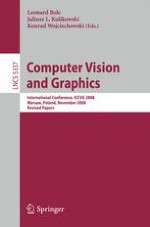This book constitutes the thoroughly refereed post-conference proceedings of the International Conference on Computer Vision and Graphics, ICCVG 2008, held in Warsaw, Poland, in November 2008. The 48 revised full papers presented were carefully reviewed and selected from numerous submissions. The papers are organized in topical sections on image processing, image quality assessment, geometrical models of objects and scenes, motion analysis, visual navigation and active vision, image and video coding, virtual reality and multimedia applications, biomedical applications, practical applications of pattern recognition, computer animation, visualization and graphical data presentation.
